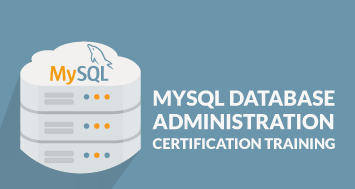MySQL DBA Certification Training

We have designed and structured MySQL DBA Certification Training to
train a learner on the core concept & advanced tools &
techniques to manage the MySQL database's administration and data. The
most important concepts like MySQL server, MySQL workbench, data
modeling, MySQL connector, database design, MySQL command line, MySQL
functions, etc., are included in the MySQL database administration
course. When this MySQL DBA certification training ends, you will be
able to create and administer your database.
Why should you take this course?
* MySQL DBA certification course is one of the most popular courses worldwide for an open-source database.
* The average salary pay for this certificate holder is about $73,973 per annum.
* All of the world's fastest and developing companies are looking for MySQL
Course Curriculum
Objective:-
The main objective of this MySQL database administration course is to make to able to use MySQL workbench, MySQL command-line, and many other exciting things.
Topics:-
* Basics of relational database
* SQL language & MySQL
* MySQL overview
* Entities and relationship
* Data manipulation language and SQL data definition language
* MySQL connectors
* MySQL workbench
* MySQL client/server model
* Using the MySQL client
* Starting and stopping MySQL server
* Installation of the MySQL server
Hands-on:-
* Using MySQL workbench
* Install and configure client, MySQL server, and MySQL workbench
* Creating the world database and explore the Schema
You will be able to normalize your data model, design a new database, evaluate a database design, describe database modeling, explain the use of different data in database design, and many more.
Topics:-
* Viewing and evaluating a database
* Database design
* Database modeling
* Keys and normalization
* Data types and database design
* Data type consideration
* Meaning of null
* Character set and collation support
* Numeric, temporal, and string data types
Hands-On:-
* Designing a new database
* Explore an existing database
* Selecting data types for your new database
Your main aim here will create a database and add tables, use the show make table statement, set column and table options, delete a database, and many more.
Topics:-
* Creating a table
* creating a database
* Showing how to create a table
* column option
* table option
* creating a new table using the existing table
* Copying an existing table structure
Hands-On:-
* Deleting a database
* Creating a database
* Creating and deleting a table
You can do query data from the application code, export and import a delimited file, and create views after completing the course.
Topics:-
* Creating views
* The select statement
* Querying data from an application
* Troubleshooting authorization levels
* Exporting and importing a delimited file
* Manipulating data and inserting records
* Replacing and updating existing records
Hands-On:-
* Importing a delimited file
* Performing basic queries from a PHP application
* Performing basic queries on imported data
* Inserting, modifying, and deleting data
* Exporting a script
At the end of the session, you will be capable of using the union keyword to combine multiple queries and use the built-in function in MySQL.
Topics:-
* Inner joins
* Outer joins
* Using function
* String function
* Data and time function
* Numeric function
* Aggregate function
* Spaces in function names
* Function in MySQL expression
* Querying in multiple tables
* Joining tables with select
Hands-on:-
* Using union in queries
* Using joins in queries
* Using numeric functions
* Using aggregate functions
You will know how to configure InnoDB tablespaces, explain how MySQL uses memory, and list some of the available plug-ins.
Topics:-
* Understanding how MySQL transmits data and process requests
* Comprehend how MySQL stores data and uses memory
* Tablespaces, redo, and undo logs.
* Plugin interface
* Architectural overview
Hands-On:-
* Configuring the buffer pool
* Configuring tablespaces
When you complete this course, you can do a database design, design a new database, normalize your data model, and do many more fun things.
Topics:-
*Server Configuration Options
*Option Files and System Variables
*Launching Multiple Servers on the Same Host
*Monitoring Tools & Techniques
*MySQL Enterprise Audit
*MySQL Enterprise Monitor
*Monitoring User Activity
Hands-On:-
* Changing dynamic settings
* Modifying the configuration file
* Using performance schema
* Configuring the slow query log
Objective:-
When this session is over, you will create user accounts, design a permission structure, control user permission, etc.
Topics:-
* Granting permission & grant tables
* Creating and modifying user accounts
* Configuring passwords
*Authentication plug-ins
Hands-On:-
* Granting permissions
* Creating users
At the end of this session, you will understand one of the main concerns is the security of the database by using MySQL.
Topics:-
* Network security risks
* Understanding security risks
* Password and operating system security
Hands-on:-
* Enable SSL connections on the MySQL server
Course Description
MySQL database administration course is one of the most famous open-source databases and is in demand nowadays. This course is only the first step to achieve MySQL DBA certification and gaining a strong foundation & hands-on experience in using and administering this open-source relational database. Moreover, you will also comprehend the core concept and advanced tools and techniques to administer data and the MySQL database.
Course Objective
* Identify features of MySQL database
* Understand the benefits of an open-source database
* Explain the basics of relational databases
* Create a useful MySQL database
* Create database objects using SQL
* Use MySQL command-line client to populate and manipulate data.
* Access a database from applications or MySQL client tools
* Use SELECT statements to query data.
* Use various data types based on the requirement.
* Use SQL to modify the structure of your database.
* Create indexes and keys
* Utilize Join operation to query data from multiple tables.
* Explain database transactions
* Use built-in MySQL functions
* Export and import database data
* Configure MySQL server and client programs
* Configure simple and complex replication topologies
* Create and manage users
* Define and implement a backup strategy
* Perform physical and logical backups of your data
* Protect your data from common security risks
* Utilize server logs and other tools to monitor database activity
hardest Structured Query Language (SQL) to build a database and manipulate it.
All you need is basic 4Gb RAM and i3 processor or above in your computer or
laptop device.
* Learners must have a working knowledge of any command-line program.
* Basic computing knowledge.
* Basic understanding of relational database systems is an added advantage.
Features
Instructor-Led Sessions
30 hours of online live instructor clases, there is a weekend class of 10 sessions for 3 hours each.
Real-Life Case Studies
Live project based MySQL database administration course provides a better understanding of the subject.
Assignments
As every class lecture has practical work to do at the end of the day, we will give you the assignment to complete today's lesson.
Lifetime Access
By selecting this one MySQL DBA certification course, you get lifetime access to a learning management system(LMS) that includes class recordings, books, etc.
24X7 Expert Support
Once you enroll for our MySQL DBA certification training, you can access our 24X7 customer service for any doubts, queries, and many more.
Certification
At the end of the MySQL database administration course, we will provide you a certificate to help you get a job or salary increments and many more.
Forum
Through peer interaction and knowledge sharing, you can easily enrich their learning as a part of a community forum for all our customers.
Frequently Asked Questions (FAQs):
We will never let you miss any of our sessions by providing you a recording of every class if you have some work and could not join the session till the end of MySQL DBA certification training.



